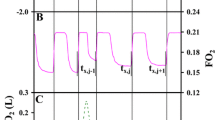Abstract
A specific ventilation pattern incorporating a single deep breath is used to demonstrate the possibility of estimating six cardiopulmonary parameters by measuring respiratory flow and expired oxygen and carbon dioxide concentrations at the mouth. Equations are derived from both alternating and continuous ventilation models of gas exchange which allow the six parameter estimates to be computed. The results indicate that pulmonary capillary blood flow, functional residual capacity, equivalent lung volume, mixed venous PO2 and PCO2, and pulmonary tissue plus capillary blood volume can be estimated in subjects with normal gas exchange.
The use of a mechanical ventilator to provide a uniform ventilation pattern before and after the ventilator induced deep breath is the key to the methods simplicity. This allowed parameter estimates to be obtained which could then be analyzed for accuracy and precision. The feasibility of estimating these parameters, demonstrated by the present study, suggests that a recursive least squares estimation procedure could be used to recover the time variation of each parameter during exercise stress testing of subjects with normal or nearly normal gas exchange.
Similar content being viewed by others
References
Christiansen J, Douglas CG, Haldane JS: The absorption and dissociation of carbon dioxide by human blood. J Physiol 48: 244–271, 1914.
Dubois AB, Britt AG, Fenn WO: Alveolar CO2 during the respiratory cycle. J Appl Physiol 4: 535–548, 1952.
Knowles JH, Newman W, Fenn WO: Determination of oxygenated mixed venous blood CO2 tension by a breath holding method. J Appl Physiol 15: 225–228, 1960.
Fenn WO, Dejours P: Composition of alveolar air during breath holding with and without prior inhalation of oxygen and carbon dioxide. J Appl Physiol 313–319, 1954.
Kim TS, Rahn H, Farhi LE: Estimation of true venous and arterial PCO2 by gas analysis of a single breath. J Appl Physiol 21: 1338–1344, 1966.
Chinard FP, Enns T, Nolan MF: Contributions of bicarbonate ion and of dissolved CO2 to expired CO2 in dogs. Am J Physiol 198: 78, 1960.
Chinard FP: The permeability characteristics of the pulmonary blood-gas barrier. In: Caro CG. (ed.) Advances in Respiratory Physiology, Williams and Wildins Co., Baltimore, 1966.
Feisal KA, Sackner MA, DuBois AB: Comparison between the time available and the time required for CO2 equilibration in the lung. J Clin Invest 42: 24, 1963.
Hyde RW, Puy RJM, Raub WF, Forster RE: Rate of disappearance of labeled carbon dioxide from the lungs of humans during breath holding; a method for studying the dynamics of pulmonary CO2 exchange. J Clin Invest 47: 1535–1552, 1968.
Sackner MA, Feisal KA, DuBois AB: Determination of tissue volume and carbon dioxide dissociation slope of the lungs in man. J Appl Physiol 19: 374–380, 1964.
Cander L, Forster RE: Determination of pulmonary parenchymal tissue volume and pulmonary capillary blood flow in man. J Appl Physiol 14: 541–551, 1959.
Burwell SC, Robinson GC: A method for the determination of the amount of oxygen and carbon dioxide in the mixed venous blood of man. J Clin Invest 1: 47–63, 1924.
Ceretelli P, Cruz JC, Farhi LE, Rahn H: Determination of mixed venous O2 and CO2 tensions and cardiac output by a rebreathing method. Resp Physiol 1: 258–264, 1966.
Ceretelli P, Di Pranpero PE, Rennie DW: Measurement of mixed venous oxygen tension by a modified rebreathing procedure. J Appl Physiol 28: 707–711, 1970.
Ellis FR, Spence AA: A critical evaluation of a nitrogen rebreathing method for the estimation of PVO2. J Physiol 211: 19P, 1970.
Reynolds WJ, Milhorn HT, Holloman GH: Transient ventilatory response to graded hypercapnia in man. J Appl Physiol 33: 47, 1972.
McMichael J: A rapid method of determining lung capacity. Clin Sci 4: 167–173, 1939.
Cournand A, Baldwin E, Darling RC, Richards DW: Studies on the intrapulmonary mixture of gases. IV. The significance of the Pulmonary emptying rate and a simplified open circuit measurement of residual air. J Clin Invest 20: 681–689, 1941.
DuBois AB, Botelho SY, Bedell GN, Marshall R, Comroe JH Jr.: A rapid plethysmographic method for measuring thoracic gas volume: A comparison with a nitrogen washout method for measuring functional residual capacity in normal subjects. J Clin Invest 35: 322–326, 1956.
Briscoe WA: Lung Volumes. Handbook of Physiology, Sec. 3. Respiration, Vol. 2. Washington DC, Amer Physiol Soc 1965, pp 1345–1379.
Fowler WS, Cornish ER, Kety SS: Lung function studies VIII. Analysis of alveolar ventilation by pulmonary N2 clearance curves. J Clin Invest 31: 40–50, 1952.
Hickam JB, Frayser R: A comparative study of intrapulmonary gas mixing and functional residual capacity in pulmonary emphysema, using helium and nitrogen as the test gases. J Clin Invest 37: 567–573, 1958.
Box GE, Jenkins GM: Time Series Analysis-forecasting and Control. Holden-Day Inc, San Francisco, 1970, p 17.
Chilton AB, Stacy RW: A mathematical analysis of carbon dioxide respiration in man. Bull Math Biophys 14: 1–18, 1952.
DuBois AB, Britt AG, Fenn WO: Alveolar CO2 during the respiratory cycle. J Appl Physiol 4: 535, 1952.
Chilton AB, Barth DS, Stacy RW: A mathematical analysis of oxygen respiration in man. Bull Math Biophys 16: 1, 1954.
Yamamoto W, Hori T: Phasic air movement model of respiratory regulation of carbon dioxide balance. Comp Biomed Res 3: 699–717, 1971.
Kelman JA, Homer LD: The analysis of pulmonary and cardiovascular parameters with a mathematical model of external respiration. Math Biosci 13: 369–388, 1972.
Suwa J, Bendixen HH: Pulmonary gas exchange in a tidally ventilated single alveolus model. J Appl Physiol 32: 834–841, 1972.
Dresdner RD, Mitchell RR, Osborn JJ: A model evaluation of carbon dioxide dilution in the pulmonary system. San Diego Biomedical Symposium Proceedings 13: 241–248, 1974.
Kelman GR: Digital computer procedure for the conversion of PCO2 into blood CO2 content. Respir Physiol 3: 111–115, 1967.
Comroe JH Jr. et al.: The Lung. Year Book Medical Publishers, Inc, Chicago, 1963.
Author information
Authors and Affiliations
Rights and permissions
About this article
Cite this article
Mitchell, R.R. A deep breath method for noninvasive estimation of cardiopulmonary parameters. J Clin Monit Comput 5, 53–64 (1988). https://doi.org/10.1007/BF01739233
Accepted:
Issue Date:
DOI: https://doi.org/10.1007/BF01739233




